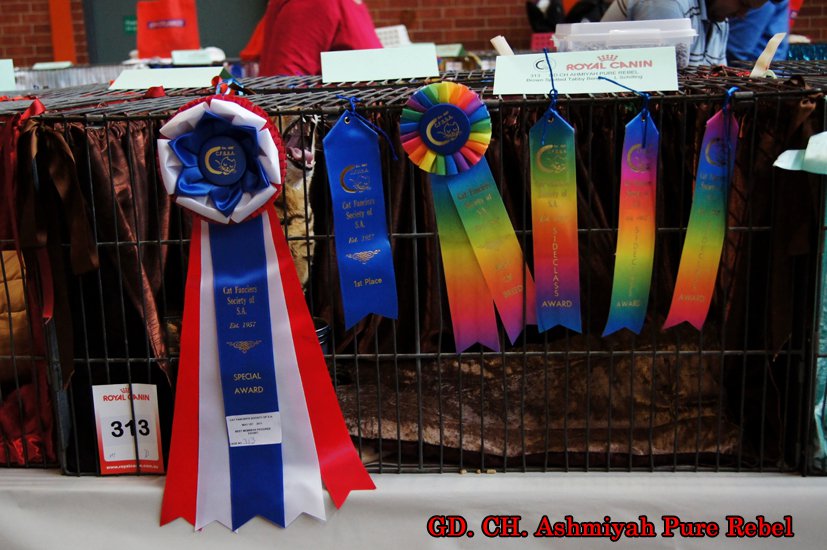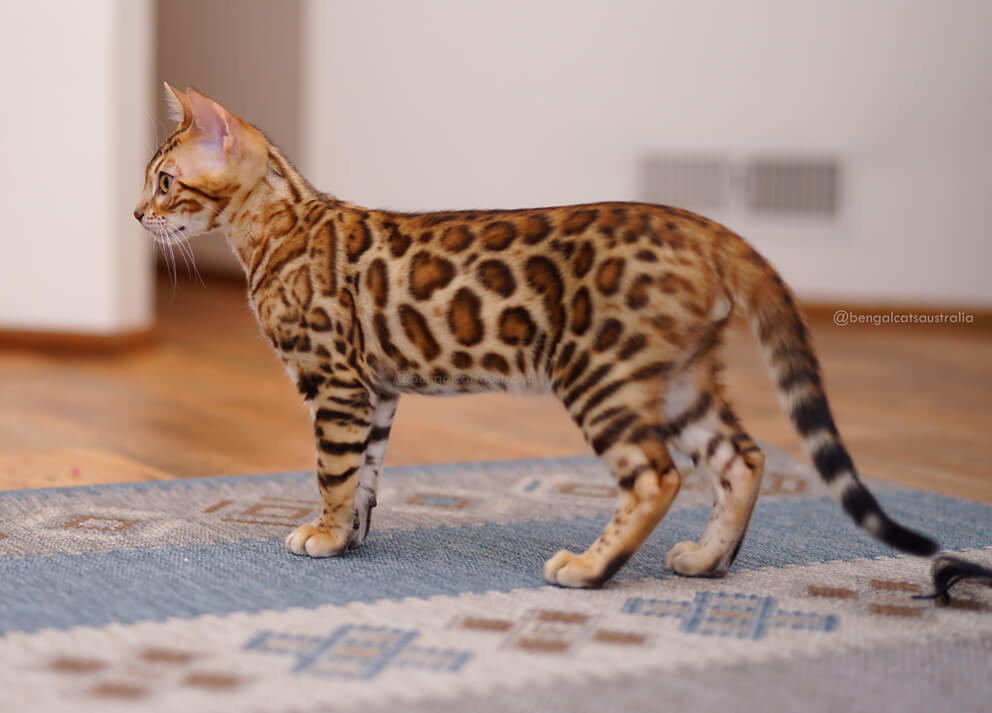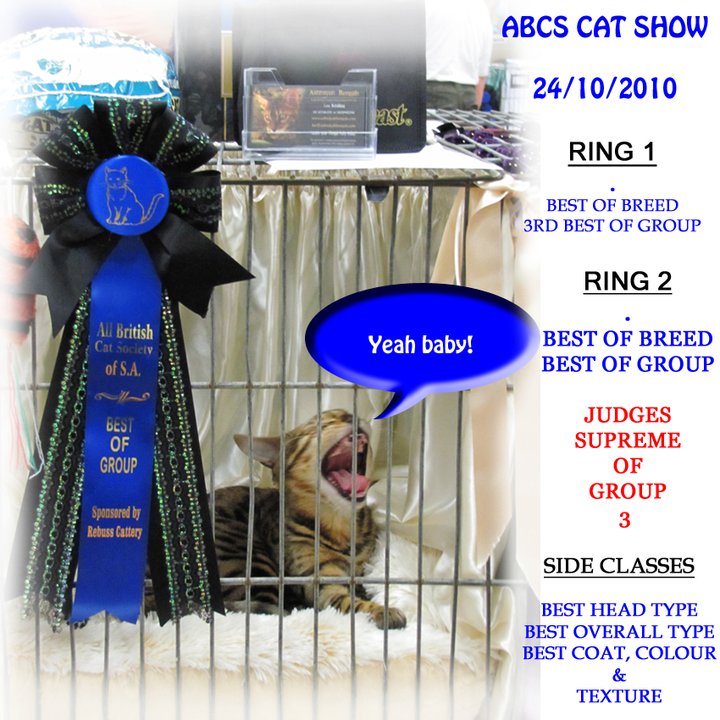Bengal Cat Breed Standard
BENGAL [BEN] (Standard Source: TICA 1996 / CCCA 2019 Charcoal / TICA 2021 Blue)
Standard General Description
The goal of the Bengal breeding program is to create a domestic cat which has the physical features
distinctive to the small forest-dwelling wild cats, but with the loving dependable temperament of the domestic cat.
Keeping this goal in mind, judges shall give special merit to those characteristics in the appearance of the Bengal which are distinct from those found in other domestic cat breeds.
Breed Traits
A Bengal cat is an athletic animal, alert to its surroundings; a friendly, curious, confident cat with strength, agility, balance and grace.
It is a medium to large cat which exhibits a very muscular and solid build. Its wide nose with prominent whisker pads and large oval, almost round eyes in a slightly small head enhance the wild appearance and expressive nocturnal look. It’s very slight, to nearly straight, concave profile and relatively short ears with wide base and rounded tips add to the Bengal’s distinctive and unique appearance.
The short, dense coat has a uniquely soft and silky feel. The coat may be glittered or not glittered, with neither type to be given preference. A thick, low-set, medium length tail adds balance to the cat.
The Bengal Head
Broad modified wedge with rounded contours. Longer than it is wide. Slightly small in proportion to body, but not to be taken to extreme. The skull behind the ears makes a gentle curve and flows into the neck. Overall look of the head should be as distinct from the domestic cat as possible.
Muzzle is full and broad, with large, prominent whisker pads and high, pronounced cheekbones. Slight muzzle break at the whisker pads. Allowance to be made for jowls in adult males.
In profile curve of the forehead should flow into the bridge of the nose with no break. Bridge of nose extends above the eyes; the line of the bridge extends to the nose tip, making a very slight, to nearly straight, concave curve. Nose is large and wide; slightly puffed nose leather.
Chin is strong, aligns with tip of nose in profile. Neck is long, substantial, muscular; in proportion to the head and body.
Bengal Ears
Medium to small, relatively short, with wide base and rounded tops. Set as much on side as top of head, following the contour of the face in the frontal view, and pointing forward in the profile view. Light horizontal furnishings acceptable, but lynx-like tufts [vertical] are undesirable.
Bengal Eyes
Oval, almost round, allowance for slight almond shape. Large, but not bugged. Set wide apart, back into face, and on slight bias toward base of ear. The more richness and depth of colour the better. Both eyes to be of the same colour.
Bengal Body
Long and substantial, not oriental or foreign. Medium to large (but not quite as large as the largest domestic breed). Boning is sturdy, firm; never delicate. Very muscular, especially in the males, one of the most distinguishing features. Allowance for smaller size, in balanced proportion of females.
Legs and Feet
Medium length, slightly longer in the back than in the front. Feet large, round, with prominent knuckles.
Bengal Tail
Medium length, thick, tapered at end with rounded tip.
Bengal Coat
Short to medium length. Allowance for slightly longer coat in kittens. Dense and
luxurious, close lying, unusually soft and silky to the touch.
SCALE OF POINTS
Head 10 points
Ears 10 points
Eyes 5 points
Neck 5 points
Body 10 points
Legs 5 points
Feet 5 points
Coat 10 points
Colour 10 points
Pattern 30 points
————
100 points
Breed Standard Recognised Colours & Patterns
Eye Colour: The more richness and depth of colour the better. Both eyes to be of the same colour.
Brown Tabby & Black Silver Tabby (spotted/marbled): any colour except blue or aqua.
Blue Tabby (spotted/marbled): any colour except blue.
Blue Silver Tabby (spotted/marbled): gold to green.
Seal Sepia Tabby and Seal Silver Sepia Tabby: gold to green.
Blue Sepia Tabby and Blue Silver Sepia Tabby: green gold.
Seal Mink Tabby and Seal Silver Mink Tabby: blue-green (aqua).
Blue Mink Tabby and Blue Silver Mink Tabby: aqua (varies from blue-green to turquoise).
Seal Tabby Point and Seal Silver Tabby Point: blue.
Blue Tabby Point and Blue Silver Tabby Point: blue.
Brown Charcoal Tabby and Black Silver Charcoal Tabby: gold, green or hazel with deep shades preferred and should harmonise with intensity of coat colour.
Blue Charcoal Tabby and Blue Silver Charcoal Tabby: gold, green or hazel with deep shades preferred and should harmonise with intensity of coat colour.
Coat Colour: Only as listed below
Coat Pattern: Tabby pattern comes as spotted, marbled and charcoal only.
Spotted (24) Spots shall be random or aligned horizontally. Rosettes formed by a part-circle of spots around a distinctly redder centre are preferable to single spotting, but not required.
Contrast: with ground colour must be extreme, giving distinct pattern and sharp edges. Strong, bold chin strap and mascara markings desirable. Blotchy horizontal shoulder streaks desirable. Belly must be spotted.
Marbled (22) Markings, while derived from the classic tabby gene, shall be uniquely different with as little “bulls-eye” similarity as possible. Pattern shall, instead, be random giving the impression of marble, preferably with a horizontal flow when the cat is stretched. Vertical striped mackerel influence is also undesirable. Preference should be given to cats with three or more shades; i.e., ground colour, markings, and dark outlining of those markings.
Contrast: must be extreme, with distinct shapes and sharp edges. Belly must be spotted.
Charcoal (t) Markings: Definite contrast between ground colour and markings, with distinct shapes, and clearly defined edges. Pattern to have a horizontal flow. Preference is given to very dark markings, with clear outlines, and well contrasted on the ground colour. There must be white, or nearly white spectacles or “goggles” encircling the eyes. A dark mask runs all the way from the nose bridge to the nose and connects from the mascara lines all the way to the nose bridge. A wide, dark, “cape” running down the length of the back is desirable. Colour on chest and belly should be lighter than ground colour. Charcoals can be Spotted, or Marble Pattern.
Remarks: Do not penalise for mousy undercoat.
Faults: Spots on body running together vertically forming a mackerel tabby pattern, circular bullseye pattern on marbleds, substantially darker point colour (as compared to colour of body
ACF STANDARDS Bengal Page 3 Effective 1 September 2021
markings) on Tabby Points, Seal Sepia or Seal Mink.
Silver Series: Any rufism/tarnishing in silver areas.
Withhold Challenge: Belly not spotted. Paw pads not consistent with their colour group description, or paw
pads not all the same colour. Any distinct locket on the neck, chest, abdomen or any
other area not provided for in the breed standard
An Important Tool For All Breeders
A Breed Standard is a critical component in the breeding and showing of Bengal cats. These standards serve as a blueprint for breeders, outlining the ideal characteristics, temperament, and physical traits that define the breed.
For Bengal cats, this includes specifics such as the coat pattern, coloration, body structure, and distinctive wild appearance reminiscent of their Asian leopard cat ancestry.
Adhering to the Standard ensures that breeders maintain the integrity and quality of the breed, producing cats that not only meet aesthetic criteria but also embody the breed’s unique personality traits and health standards.
In the context of showing, Breed Standards are equally important. They provide a clear and objective set of criteria for judges to evaluate the cats presented in competitions.
For Bengal cats, show judges look for attributes such as a muscular, athletic build, a sleek, dense coat with rosettes or spots, and a confident, alert demeanor. By adhering to these standards, shows can maintain a level playing field, allowing the best examples of the breed to be recognized and rewarded.
This recognition not only promotes the breed but also encourages breeders to strive for excellence, continually improving their breeding programs.
Ashmiyah Show Winners






